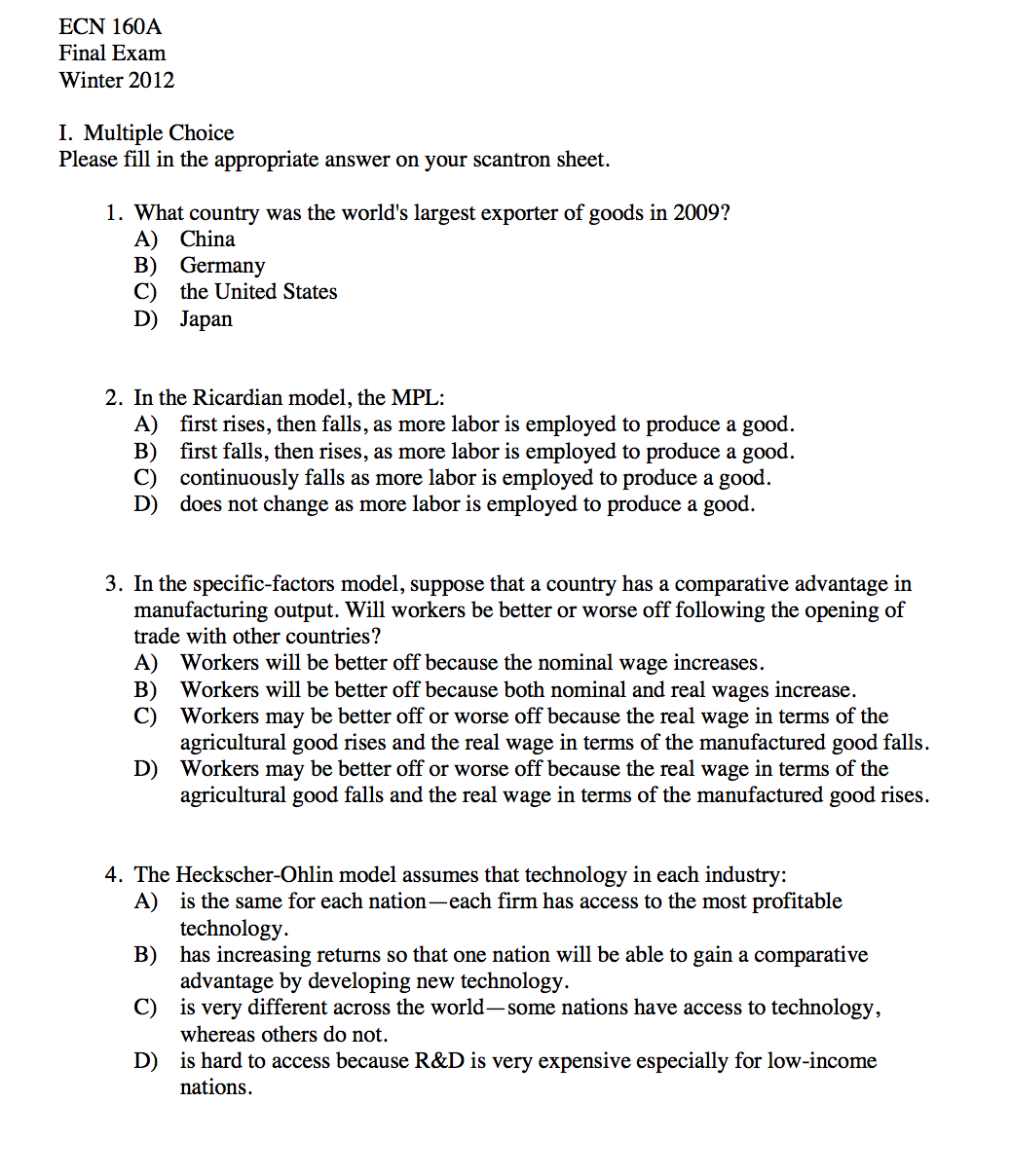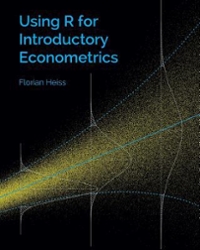Question
multiple choice questions I. Multiple Choice Please fill in the appropriate answer on your scantron sheet. 1.What country was the world's largest exporter of goods
multiple choice questions
I. Multiple Choice
Please fill in the appropriate answer on your scantron sheet.
1.What country was the world's largest exporter of goods in 2009?
A)China
B)Germany
C)the United States
D)Japan
2.In the Ricardian model, the MPL:
A)first rises, then falls, as more labor is employed to produce a good.
B)first falls, then rises, as more labor is employed to produce a good.
C)continuously falls as more labor is employed to produce a good.
D)does not change as more labor is employed to produce a good.
3.In the specific-factors model, suppose that a country has a comparative advantage in manufacturing output. Will workers be better or worse off following the opening of trade with other countries?
A)Workers will be better off because the nominal wage increases.
B)Workers will be better off because both nominal and real wages increase.
C)Workers may be better off or worse off because the real wage in terms of the agricultural good rises and the real wage in terms of the manufactured good falls.
D)Workers may be better off or worse off because the real wage in terms of the agricultural good falls and the real wage in terms of the manufactured good rises.
4.The Heckscher-Ohlin model assumes that technology in each industry:
A)is the same for each nation?each firm has access to the most profitable technology.
B)has increasing returns so that one nation will be able to gain a comparative advantage by developing new technology.
C)is very different across the world?some nations have access to technology, whereas others do not.
D)is hard to access because R&D is very expensive especially for low-income nations.
5.The Mariel boatlift of Cuban immigrants into Miami caused the:
A)population of unskilled workers in Miami to decline.
B)population of skilled workers in Miami to decline.
C)supply of labor to increase, but it did not decrease the wages.
D)wages of all workers to decline.
6.A monopolistic competitor has fixed costs of $100 and marginal costs of $10 per unit. What is its average cost of producing 100 units?
A)$10
B)$11
C)$1,100
D)$2,000
7.In the long run, profits in a monopolistic competition market are zero because:
A)of government regulations.
B)of collusion.
C)firms are free to enter and exit the market.
D)firms produce a differentiated product.
8.In the long run, a monopolistically competitive firm will produce where:
A)average cost equals price.
B)average cost equals marginal revenue.
C)marginal revenue equals price.
D)marginal cost equals price.
9.A case study of wages in the United States from 1983 to 2006 shows:
A)a decrease in white-collar wages due to offshoring.
B)a relative increase in skilled worker wages (nonproduction) compared with less- skilled wages (production).
C)a decrease in employment of skilled workers.
D)a relative decrease in skilled worker wages (nonproduction) compared with less- skilled wages (production).
10.An isoquant describes:
A)combinations of two goods that a country can produce if it fully and efficiently uses its resources.
B)combinations of goods that yield the same satisfaction to consumers.
C)combinations of inputs that produce a constant level of output.
D)combinations of value-chain activities needed to produce output.
11.Normally the WTO does not allow discriminatory treatment in trade of member nations, but it makes an exception for nations:
A)that have a large trade surplus.
B)using environmentally harmful production techniques.
C)that cannot control drugs and other illegal activities.
D)engaging in regional free-trade agreements.
12.The presidential candidate who, during a nationally televised debate in 1992, said that Mexico would generate "a giant sucking sound" of investment draining out of the U.S. if NAFTA were to be enacted was
A)Bill Clinton.
B)RossPerot.
C)George H.W. Bush.
D)None of the above.
13.A case study of Japanese auto imports during the 1980s focuses on an agreement between Japan and the United States to undertake a:
A)coordinated effort to improve gas mileage.
B)study of wage concessions by Japanese car makers in the United States.
C)review of unionization and employee benefits in both nations.
D)voluntary export restraint.
14.A major reason why the Doha Round was unsuccessful was disagreements over:
A)tariffs in developed countries.
B)export subsidies to agriculture in land-rich developed countries.
C)production subsidies to agriculture in land-poor developing countries.
D)tariffs on agricultural imports in developing countries.
15.The end result of an export subsidy enacted by a large nation is to:
A)allow the home nation to sell more abroad.
B)raise the domestic price.
C)decrease the amount purchased in the home market.
D)allow the home nation to sell more abroad, raise the domestic price, and decrease the amount purchased in the home market.


Step by Step Solution
There are 3 Steps involved in it
Step: 1

Get Instant Access to Expert-Tailored Solutions
See step-by-step solutions with expert insights and AI powered tools for academic success
Step: 2

Step: 3

Ace Your Homework with AI
Get the answers you need in no time with our AI-driven, step-by-step assistance
Get Started


